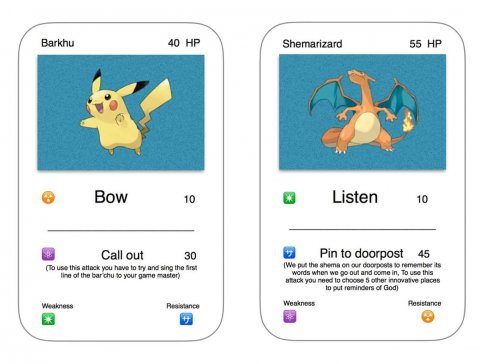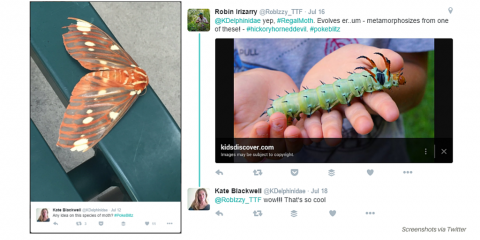Top 6 Ways to Use Pokémon Go in Jewish Education
Whether you love it or hate it, your students are -- and will be -- playing Pokémon Go. Instead of seeing the game as a further distraction, why not see it as an opportunity to bring Jewish education to life in the eyes of a teen? Here are 6 ways you can use the game to your creative advantage!
1. Create a Jewish-themed Pokémon Go by linking each Pokémon to a Jewish symbol or task.
Deborah Blausten, Student Rabbi at Finchley Reform Synagogue in London, created puns for Pokémon characters associated with specific Jewish tasks. Students completed a task using the gameplay modes from Pokémon of dice-rolling, training, etc. “I hid about 500 tiny Pokémon around the synagogue and made the rest of the game live in the shul with battle modes and pokedexes for each team,” she said. “We had [around] 100 kids playing in 15 teams across three rooms so it was very energetic!”

“I think gaming in educational settings is about creating a fully responsive environment. Pokémon Go lends itself as an idea to live action games really easily as it allows kids to take control and engage with their environment.”
Here’s how Deborah described the logistics of the game:
- The kids were split up into three gyms and there were Pokémon masters (teachers) in each room.
- They returned their captured Pokémon to the room and had to fight against it (played by the madrichim game masters) until they got the Pokemon’s strength weak enough to catch them in their pokéballs. Instead of the dice rolling and points system that enables Pokémon to use their speciality moves, they did a small activity related to the Jewish theme of that Pokémon. Then they could use the attack.
- There were also ways to strengthen their pokéballs and attacks by visiting a training room, which tested them on different Jewish concepts they had learned during the year.
2. Design a Pokémon based on your favorite Jewish historical figure or hero.
Include a character description or fact file to identify strengths and weaknesses. Here's a great example using Saul Bellow's Herzog, reimagined as a Pokémon (The Pokémon of Literature by Eric Smith):
"When summoned, Herzog plans its attacks in its mind, but never really acts them out. Sadly it’s a troubled Pokémon, who won’t be able to evolve and become useful until it comes to terms with its place in life, usually by reconnecting to Pokémon it has been distant with."

3. Teach Kashrut by asking students to hypothesize about which Pokémon may or may not be kosher.
It may sound funny to think of Pokémon this way, but it could be a creative way to learn about Kashrut! Someone has already devoted time to identifying which Pokemon are kosher! Students could also study up on what makes an animal kosher and then try and identify those features in various Pokémon to back up their classifications.
4. Get students outside exploring nature, and teach about Heschel's concept of radical amazement: "to get up in the morning and look at the world in a way that takes nothing for granted."
Finding a Pokémon can help kids discover elements of nature that they otherwise would not have come across or noticed. Once they have captured their Pokémon, what else can they “capture” and identify around them? What Jewish prayer can be used to express Hakarat ha’Tov (gratitude) and amazement?
Kids who find real animals or plants near virtual Pokémon can receive help identifying the animal from a team of scientists. After the photo is uploaded to Twitter with the hashtag #PokeBlitz, a scientist will reply with facts about the animal to help increase awareness on biodiversity.

5. Capture and learn the Jewish middot.
Dr. Karen Reiss Medwed, Assistant Teaching Professor at Northeastern University, suggested “capturing [the individual Pokémon] as middot and then enacting them to 'power up' while navigating the real world situations afforded.” A Making Mensches periodic table by Avi Orlow can be used as a resource. Students can determine which middot are associated with specific Pokémon depending on the type of Pokémon. For example, a Venusaur Pokémon, which can sooth people’s emotions, may enact Bina (understanding), Chesed (kindness), and Rachamim (compassion).
Another idea is to use your school as a digital playground for any kind of Jewish augmented reality scavenger hunt with the help of a few tech tools. "You can set up your physical Jewish day school to have various landmarks where certain things are revealed, like instructions for a scavenger hunt or other Jewish items, that you can create games and prizes around," said Olivia Friedman, Tanakh teacher at the Ida Crown Jewish Academy in Chicago, IL. Using ARIS or Traces, "you can drop videos/images that will only be revealed when someone walks to that physical location."
6. Have a caption contest or create a digital story using screenshots of Pokémon in your synagogue or at Jewish landmarks in your neighborhood.
Ask students to identify the sites, the Pokémon, and why the characters might have been visiting a particular site.
Here’s a Meowth visiting the residence of Israel's president, Reuven Rivlin. Rivlin’s caption says “Somebody call security.”

This is an opportunity for students to identify this as a room where Israeli presidents meet with world leaders, provide a quote or diary entry from Meowth on what it learned about Israel’s president Reuven Rivlin, and what it means to hold the presidential office in Israel.
Here are some Jewish landmarks in New York to get you started:
- These 5 kid-friendly Jewish museums
- Historical synagogues, such as:
- Eldridge Street synagogue, the first Eastern European Orthodox Jewish synagogue in America
- Kehila Kedosha Janina, the only Greek Jewish synagogue remaining in the Western hemisphere
- Jewish Eats: 2nd Avenue Deli, Katz Delicatessen, Yonah Schimmel Knish Bakery
- Emma Lazarus Plaque in Battery Park
If you're going to Israel, you can find Pokémon all over holy sites in Jerusalem.
Tamar Skolnick is Project Manager, Digital Marketing at The Jewish Education Project.
This post was inspired by the educators participating in a thread on the JEDLAB Facebook group.


